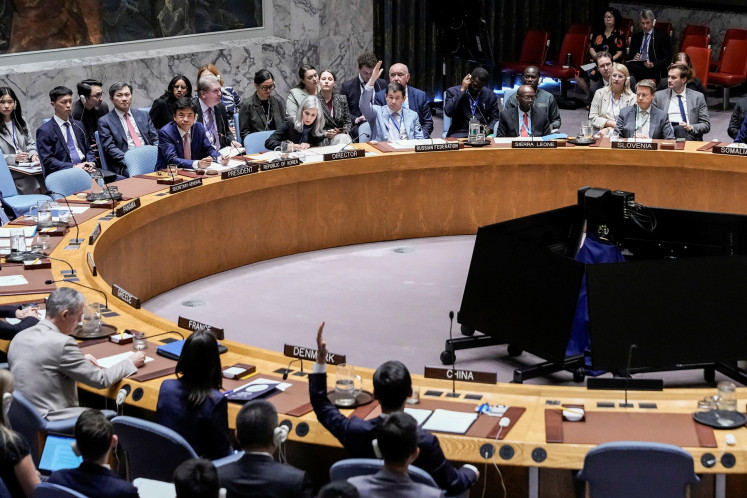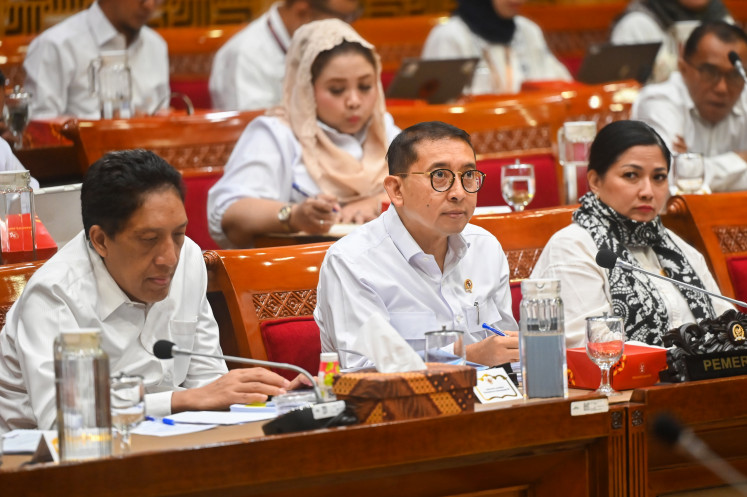Popular Reads
Top Results
Can't find what you're looking for?
View all search resultsPopular Reads
Top Results
Can't find what you're looking for?
View all search resultsMonika Jufry: ISLAMIC FASHION TRENDSETTER
(JP/Nayu Novita)Does choosing Islamic fashion mean a woman must abandon hope of looking stylish? Not so, according to Monika Jufry, the Muslim fashion designer behind well-known labels Sessa and Monika Jufry
Change text size
Gift Premium Articles
to Anyone
(JP/Nayu Novita)
Does choosing Islamic fashion mean a woman must abandon hope of looking stylish? Not so, according to Monika Jufry, the Muslim fashion designer behind well-known labels Sessa and Monika Jufry.
Rather, she says, a clever woman adjusts her style to match her character and lifestyle, and can look chic and trendy without letting the beauty of the body peek through the clothes.
“Someone who usually looks sporty doesn’t need to force herself to become feminine just because she wears Islamic dress,” says Monika.
“She can adjust the model, color and details of her headscarf and the tops and bottoms that she usually wears. This allows Islamic fashion, which covers the body from top to toe, not to give an impression of being heavy or full.”
Monika, now 34 and mother of two children, became a designer “by accident”, taking it up in 1998 with the aim of making Islamic fashion more fashionable.
After graduating from Trisakti University’s School of Economics, she took a design course at Susan Budiharjo’s School of Fashion. She also began working at the Sessa Muslim fashion boutique, owned by her mother, Gusmi Jufry.
“With my educational background, my hope was to become an office worker or follow a career in banking. But because I graduated in the middle of the economic crisis I was forced to seek alternatives outside a conventional career,” she says.
She decided to help in her mother’s business before taking it further. “I then decided to deepen my knowledge in the field of fashion.”
Time has proved her decision a good one; she has moved from working behind the scenes at her mother’s fashion shows to having her own designs — characterized by their modern simplicity — on the catwalks and praised by Indonesian fashion observers.
Monika’s designs, which sell for prices ranging from Rp 500,000 to millions of rupiah for a suit, have found favor among many celebrities, including soap opera star Vira Yuniar and singer Evie Tamala. Among her clients is First Lady Ani
Yudhoyono, who asked Monika to design a number of outfits that she wore at the 2008 Safari Ramadhan.
The designer herself admits the challenge of designing Islamic fashion brings her a satisfaction she never knew when designing ordinary clothes. Indeed, at the beginning of her career, Monika had never even worn Islamic clothes or headscarfs, only starting to dress in Islamic clothes in 2000.
“To be honest, I was initially reluctant to wear Islamic fashion,” she says. “I wasn’t ready mentally and there was the sense of being old and unsophisticated when wearing Islamic clothes.”
That sense came from the very basic styles available at the time, “Probably because no one had thought of making something different, for example, by using asymmetric pieces of material.”
The experience inspired her career course.
“In addition to my religious motivation, I also felt challenged to design Islamic clothes that were more responsive to fashion trends.”
In her designs, Monica draws inspiration from various sources, from natural landscapes and local cultures to books, magazines and the Internet. For example, thoughts of nature inspired Monika’s collection this year called Little Hut.
“That Little Hut inspiration came when I saw a small hut in the rice fields at dusk,” she says. “Its application to fashion shows through a compilation of rice colors, which are dark greenish and brown.
The bamboo matting on the walls of the shack I applied in the embroidery.”
Like all fashion designers, Monika’s attention never wavers from the newest trends and developments coming and going in the centers of the fashion world such as Milan and Paris. She applies popular designs to her Islamic fashion pieces, such as the origami-style pleated fabrics that have been popping up everywhere recently.
As “Islamic clothes have no specific reference and do not have an internationally recognized fashion show, as with ordinary clothing”, so she has little choice but to look to mainstream trends and work them into her own designs.
“It’s just that since Muslim fashion has different requirements to ordinary clothes, I have to find creative ways to apply those trends,” she says. “Whether they are applied only in the form of a detailed outline or translated using siluet [a pattern formed by using a block usually in a dark color] into another version.”
Designs that reflect the cultural wealth of the archipelago also frequently appear in Monika’s pieces; batik has long made regular appearances in Sessa collections.
The beauty of woven cloth made by craftspeople from Monika’s hometown in the Pandai Sikat area of West Sumatra elevated the collection titled “My Heritage”, shown at Jakarta Fashion Week last year.
“Indonesia has a very rich culture, and there are a variety of traditional materials that can be explored,” Monika says.
“Unfortunately, except for batik, most traditional materials are difficult to obtain because the producers do not have a good distribution and marketing system. The prices are also less competitive than batik.”
Monika’s designs under the Sessa label are available at outlets in Pasaraya Grande, Jakarta, as well as in Indonesian branches of department stores Centro and Sogo. To showcase the Monika Jufry label, made exclusively to order, Monika has just opened a boutique near her home, at the Bilangan Pondok Pinang in South Jakarta.
She also fills some orders from Malaysia and Singapore, but says that differences in the culture and style of Islamic fashion in other countries limits international orders.
“In Indonesia, the people’s tastes are more varied, but the majority like simple models,” she says.
“But in Malaysia, women like to wear baju kurung [knee length dresses] from silk with big flower motifs and bright colors.
“Indonesian tastes in Islamic fashion are closer to those of Muslims in Singapore and Turkey.”
If she knows this, it’s because observing the fashion styles from different parts of the world is one of her hobbies, although Monika, who counts Biyan among her favorite labels, tends to dress casually most days.
“For me it’s very interesting to observe the peculiarities and styles of fashion from various nations,” she says. “The most interesting are the Muslim women in Saudi Arabia who all wear a black burqa. Yet underneath they dress fashionably in brands like Dior and Chanel. You only find that out when they take off their burqas when they gather together with other Muslim women.”










